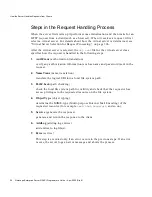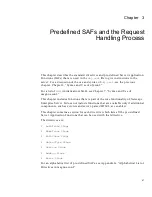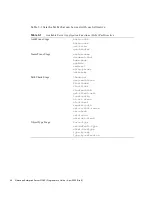
Flow of Control in obj.conf
38
Netscape Enterprise Server NSAPI Programmer’s Guide • April 2002 (Draft)
If the
NameTrans
directive assigned a name or generated a physical pathname that
matches the
name
or
ppath
attribute of another object, the server first applies the
PathCheck
directives in the matching object before applying the directives in the
default object.
ObjectType
Assuming that the
PathCheck
directives all approve access, the server next
executes the
ObjectType
directives to determine the MIME type of the request. The
MIME type has three attributes: type, encoding, and language. When the server
sends the response to the client, the type, language, and encoding values are
transmitted in the headers of the response. The
type
also frequently helps the
server to determine which
Service
directive to execute to generate the response to
the client.
If there is more than one
ObjectType
directive, the server applies all the directives
in the order in which they appear. However, once a directive sets an attribute of the
MIME type, further attempts to set the same attribute are ignored. The reason that
all
ObjectType
directives are applied is that one directive may set one attribute, for
example
type
, while another directive sets a different attribute, such as
language
.
As with the
PathCheck
directives, if another object has been matched to the request
as a result of the
NameTrans
step, the server executes the
ObjectType
directives in
the matching object before executing the
ObjectType
directives in the default
object.
Setting the Type By File Extension
Usually the default way the server figures out the MIME type is by calling the
type-by-extension
function. This function instructs the server to look up the
MIME type according to the requested resource’s file extension in the MIME types
table. This table was created during virtual server initialization by the MIME types
file, (which is usually called
mime.types)
.
For example, the entry in the MIME types table for the extensions
.html
and
.htm
is
usually:
type=text/html
exts=htm,html
which says that all files that have the extension
.htm
or .
html
are text files
formatted as HTML and the
type
is
text/html
.
Note that if you make changes to the MIME types file, you must reconfigure the
server before those changes can take effect.
Содержание ENTERPRISE SERVER 6.1
Страница 1: ...NSAPI Programmer s Guide Netscape Enterprise Server Version6 1 April 2002 Draft...
Страница 18: ...Where to Find Related Information 18 Netscape Enterprise Server NSAPI Programmer s Guide April 2002 Draft...
Страница 138: ...CGI to NSAPI Conversion 138 Netscape Enterprise Server NSAPI Programmer s Guide April 2002 Draft...
Страница 214: ...NSAPI Functions in Alphabetical Order 214 Netscape Enterprise Server NSAPI Programmer s Guide April 2002 Draft...
Страница 290: ...Miscellaneous 290 Netscape Enterprise Server NSAPI Programmer s Guide April 2002 Draft...
Страница 310: ...The Netscape LDAP Schema 310 Netscape Enterprise Server NSAPI Programmer s Guide April 2002 Draft...
Страница 318: ...cinfo 318 Netscape Enterprise Server NSAPI Programmer s Guide April 2002 Draft...
Страница 324: ...Sample MIME Types File 324 Netscape Enterprise Server NSAPI Programmer s Guide April 2002 Draft...
Страница 336: ...Buffered Streams 336 Netscape Enterprise Server NSAPI Programmer s Guide April 2002 Draft...
Страница 344: ...344 Netscape Enterprise Server NSAPI Programmer s Guide April 2002 Draft...
Страница 350: ...350 Netscape Enterprise Server NSAPI Programmer s Guide April 2002 Draft...
Страница 356: ...356 Netscape Enterprise Server NSAPI Programmer s Guide April 2002 Draft...






























